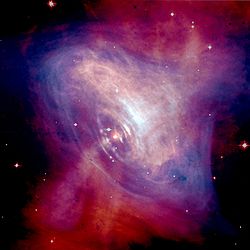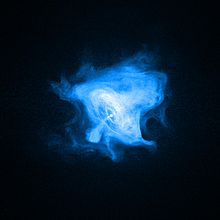- Crab Pulsar
-
Crab Pulsar Observation data
Epoch J2000 Equinox J2000Constellation Taurus Right ascension 05h 34m 31.97s Declination +22° 00' 52.1"' Apparent magnitude (V) 16.5 Characteristics Evolutionary stage Neutron star U−B color index -0.45 B−V color index +0.5 Astrometry Proper motion (μ) RA: -14.7±0.8[2] mas/yr
Dec.: 2.0±0.8[2] mas/yrDistance 2000[2] pc Details Mass ? M☉ Radius ? R☉ Luminosity ? L☉ Temperature ? K Rotation 33.08471603 ms[2] Age 957 (as of 2011) years Other designations Database references SIMBAD pulsar data The Crab Pulsar (PSR B0531+21) is a relatively young neutron star. The star is the central star in the Crab Nebula, a remnant of the supernova SN 1054, which was widely observed on Earth in the year 1054.[3][4][5] Discovered in 1968, the pulsar was the first to be connected with a supernova remnant.[6]
 A slow-motion movie of the Crab Pulsar taken at 800 nm wavelength using a Lucky Imaging camera from Cambridge University, showing the bright pulse and fainter interpulse.
A slow-motion movie of the Crab Pulsar taken at 800 nm wavelength using a Lucky Imaging camera from Cambridge University, showing the bright pulse and fainter interpulse.
The optical pulsar is roughly 25 km in diameter and the pulsar "beams" rotate once every 33 milliseconds, or 30 times each second. The outflowing relativistic wind from the neutron star generates synchrotron emission, which produces the bulk of the emission from the nebula, seen from radio waves through to gamma rays. The most dynamic feature in the inner part of the nebula is the point where the pulsar's equatorial wind slams into the surrounding nebula, forming a termination shock. The shape and position of this feature shifts rapidly, with the equatorial wind appearing as a series of wisp-like features that steepen, brighten, then fade as they move away from the pulsar into the main body of the nebula. The period of the pulsar's rotation is slowing by 38 nanoseconds per day due to the large amounts of energy carried away in the pulsar wind.[7]
The Crab Nebula is often used as a calibration source in X-ray astronomy. It is very bright in X-rays and the flux density and spectrum are known to be constant, with the exception of the pulsar itself. The pulsar provides a strong periodic signal that is used to check the timing of the X-ray detectors. In X-ray astronomy, 'crab' and 'millicrab' are sometimes used as units of flux density. A millicrab corresponds to a flux density of about 2.4x10−11 erg s−1 cm−2 (2.4x10−14 W m−2) in the 2–10 keV X-ray band, for a "crab-like" X-ray spectrum, which is roughly a powerlaw in photon energy, I(E)=9.5 E-1.1. Very few X-ray sources ever exceed one crab in brightness.
History
The modern history of the Crab Pulsar begins with the identification of the central star of the nebula in optical light. Focus was made on two stars near the center of the nebula (referred to in the literature as the "north following" and "south preceding" stars). In September 1942, Walter Baade rules out the north following star but finds the evidence inconclusive for the south preceding.[8] Rudolf Minkowski, in the same issue of Astrophysical Journal as Baade, advances spectral arguments claiming the "evidence admits, but does not prove, the conclusion that the south preceding star is the central star of the nebula".[9]
In late 1968, David H. Staelin and Edward C. Reifenstein III reported the discovery of two pulsating radio sources "near the crab nebula that could be coincident with it" using the 300-foot Green Bank radio antenna.[10] They were given the designations NP 0527 and NP 0532. The period and location of the Crab Nebula pulsar NP 0532 was discovered by Richard Lovelace and collaborators November 10, 1968 at the Arecibo radio observatory [11].
A subsequent study by them including William D. Brundage also found that the NP 0532 source is located at the Crab Nebula.[12] A radio source was also reported coincident with the crab nebula in late 1968 by L. I. Matveenko in Soviet Astronomy.[13]
Optical pulsations were reported by Nather, Warner, and Macfarlane in February 1969.[14]
Jocelyn Bell Burnell, who discovered the first pulsar PSR B1919+21 in 1967, relates that in the late 1950s a woman viewed the Crab Nebula source at the University of Chicago's telescope, then open to the public, and noted that it appeared to be flashing. The astronomer she spoke to, Elliot Moore, disregarded the effect as scintillation, despite the woman's protestation that as a qualified pilot she understood scintillation and this was something else. Bell Burnell notes that the 30 Hz frequency of the Crab Nebula optical pulsar is difficult for many people to see.[15][16]
A planetary companion?
In 1970, astronomer Curtis Michel proposed the presence of a planetary companion to explain certain variations observed in pulsar timing.[17] The hypothesized object would have a mass of 0.00001 Solar masses (i.e. 0.01 Jupiter masses or 3.3 Earth masses) and be located at 0.3 astronomical units from the pulsar.
The Crab Pulsar system Companion
(in order from star)Mass Semimajor axis
(AU)Orbital period
(days)Eccentricity b (unconfirmed) ≥3.28 M⊕ 0.3 ? ? References
- ^ "Space Movie Reveals Shocking Secrets of the Crab Pulsar" (Press release). NASA. September 19, 2002. http://hubblesite.org/newscenter/archive/releases/2002/24/image/a.
- ^ a b c d ATNF Pulsar Catalogue database entry. See Manchester, R. N.; et al. (2005), "The Australia Telescope National Facility Pulsar Catalogue", Astronomical Journal 129 (4): 1993, arXiv:astro-ph/0412641, Bibcode 2005AJ....129.1993M, doi:10.1086/428488
- ^ Supernova 1054 - Creation of the Crab Nebula
- ^ Duyvendak, J. J. L. (1942), "Further Data Bearing on the Identification of the Crab Nebula with the Supernova of 1054 A.D. Part I. The Ancient Oriental Chronicles", Publications of the Astronomical Society of the Pacific 54: 91, Bibcode 1942PASP...54...91D, doi:10.1086/125409
Mayall, N. U.; Oort, Jan Hendrik (1942), "Further Data Bearing on the Identification of the Crab Nebula with the Supernova of 1054 A.D. Part II. The Astronomical Aspects", Publications of the Astronomical Society of the Pacific 54: 95, Bibcode 1942PASP...54...95M, doi:10.1086/125410 - ^ Brecher, K.; et al. (1983), "Ancient records and the Crab Nebula supernova", The Observatory 103: 106, Bibcode 1983Obs...103..106B
- ^ Zeilik, Michael; Gregory, Stephen A. (1998), Introductory Astronomy & Astrophysics (4th ed.), Saunders College Publishing, p. 369, ISBN 0030062284
- ^ Supernovae, Neutron Stars & Pulsars
- ^ Baade, Walter (1942), "The Crab Nebula", Astrophysical Journal 96: 188, Bibcode 1942ApJ....96..188B, doi:10.1086/144446
- ^ Minkowski, Rudolf (1942), "The Crab Nebula", Astrophysical Journal 96: 199, Bibcode 1942ApJ....96..199M, doi:10.1086/144447
- ^ Staelin, David H.; Reifenstein, III, Edward C. (1968), "Pulsating radio sources near the Crab Nebula", Science 162 (3861): 1481, Bibcode 1968Sci...162.1481S, doi:10.1126/science.162.3861.1481, JSTOR 1725616, PMID 17739779
- ^ IAU Circ. No. 2113, 1968
- ^ Reifenstein, III, Edward C.; Staelin, David H.; Brundage, William D. (1969), "Crab Nebula Pulsar NPO527", Physical Review Letters 22 (7): 311, Bibcode 1969PhRvL..22..311R, doi:10.1103/PhysRevLett.22.311
- ^ Matveenko, L. I. (1968), "Position of a Source of Small Angular Size in the Crab Nebula", Soviet Astronomy 12: 552, Bibcode 1968SvA....12..552M
- ^ Nather, R. E.; Warner, B.; Macfarlane, M. (1969), "Optical Pulsations in the Crab Nebula Pulsar", Nature 221 (5180): 527, Bibcode 1969Natur.221..527N, doi:10.1038/221527a0, http://www.nature.com/nature/journal/v221/n5180/abs/221527a0.html
- ^ Brumfiel (2007), "Air force had early warning of pulsars", Nature 448 (7157): 974–975, Bibcode 2007Natur.448..974B, doi:10.1038/448974a, PMID 17728726, http://www.nature.com/nature/journal/v448/n7157/full/448974a.html
- ^ "Beautiful Minds: Jocelyn Bell Burnell", BBC television documentary broadcast 7 April 2010
- ^ Curtis (1970), "Pulsar Planetary Systems", The Astrophysical Journal Letters 159: 25–28, Bibcode 1970ApJ...159...25D, doi:10.1086/150287
Categories:- Pulsars
- Hypothetical planetary systems
- Taurus constellation
- Optical pulsars
Wikimedia Foundation. 2010.


